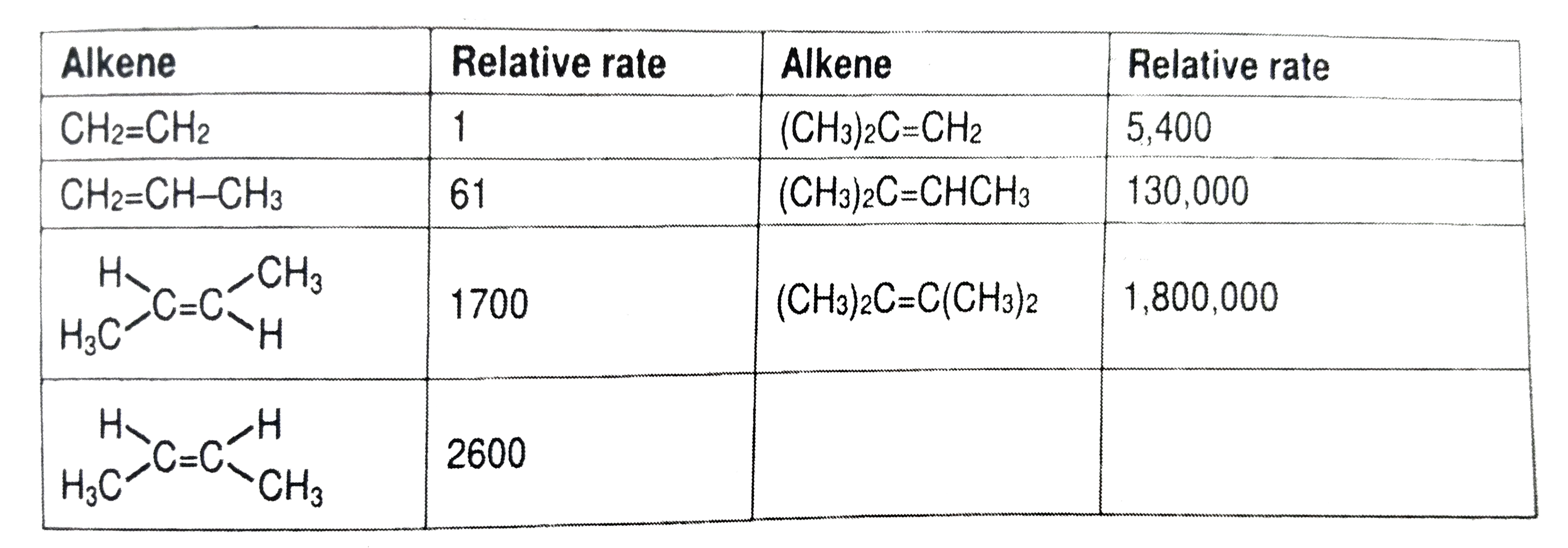Slowest rate of electrophilic addition will take place in




The correct Answer is:B
To determine the slowest rate of electrophilic addition in alkenes, we need to analyze the electron density of the alkenes in question. The electrophilic addition reaction is influenced by the electron density of the double bond in the alkene; the lower the electron density, the slower the reaction.
1. Identify the Alkenes:
We need to consider the given options for the alkenes. Let's assume we have four alkenes with different substituents.
2. Understand Electrophilic Addition:
Electrophilic addition involves an electrophile attacking the electron-rich double bond of an alkene. The rate of this reaction is influenced by the electron density of the alkene.
3. Analyze Electron Density:
- Alkene with electron-donating groups (like -OH or -CH3) will have higher electron density, making them more reactive towards electrophiles.
- Alkene with electron-withdrawing groups (like -NO2) will have lower electron density, making them less reactive and thus slower in electrophilic addition.
4. Evaluate Each Alkene:
- If one alkene has a -NO2 group, it will exhibit a -M (minus mesomeric) effect, withdrawing electron density from the double bond, leading to a slower reaction.
- Compare this with other alkenes that have groups like -OH (which has a +M effect) or -CH3 (which has a +I effect). These groups increase electron density.
5. Determine the Slowest Alkene:
After analyzing the effects of the substituents, we find that the alkene with the -NO2 group has the least electron density and thus will have the slowest rate of electrophilic addition.
6. Conclusion:
Therefore, the alkene with the -NO2 substituent will exhibit the slowest rate of electrophilic addition.
Final Answer:
The slowest rate of electrophilic addition will take place in the alkene with the -NO2 group.
---
We need to consider the given options for the alkenes. Let's assume we have four alkenes with different substituents.
Electrophilic addition involves an electrophile attacking the electron-rich double bond of an alkene. The rate of this reaction is influenced by the electron density of the alkene.
- Alkene with electron-donating groups (like -OH or -CH3) will have higher electron density, making them more reactive towards electrophiles.
- Alkene with electron-withdrawing groups (like -NO2) will have lower electron density, making them less reactive and thus slower in electrophilic addition.
- If one alkene has a -NO2 group, it will exhibit a -M (minus mesomeric) effect, withdrawing electron density from the double bond, leading to a slower reaction.
- Compare this with other alkenes that have groups like -OH (which has a +M effect) or -CH3 (which has a +I effect). These groups increase electron density.
After analyzing the effects of the substituents, we find that the alkene with the -NO2 group has the least electron density and thus will have the slowest rate of electrophilic addition.
Therefore, the alkene with the -NO2 substituent will exhibit the slowest rate of electrophilic addition.
The slowest rate of electrophilic addition will take place in the alkene with the -NO2 group.
Similar Questions
Knowledge Check
Fastest rate of electrophilic addition will take place in
A B
B C
C D
D
Fastest rate of electrophilic addition takes place in:
A B
B C
C D
D
Which one is electrophilic addition
ACH3−CH3+Cl2→C2H5Cl+HClBCH3CH=O+HCN→(CH3)2C(OH)CNC(CH3)2C=O+HCN→CH3CH(OH)CNDCH2=CH2+Br2→CH2BrCH2Br
Electrophilic Addition Reaction
View SolutionAddition reaction takes place in
View SolutionElectrophilic substitution in phenol takes place at
View SolutionConsider experimental data shown in the table :

Which of the following would be expected to have highest rate of electrophilic addition of Br2 ?
View SolutionWhich of the following compounds is the most reactive towards electrophilic addition reactions?
View Solution